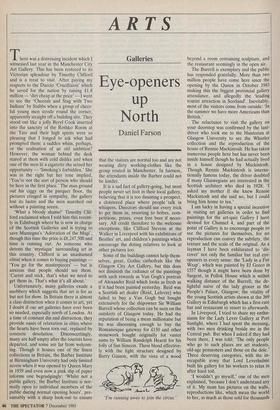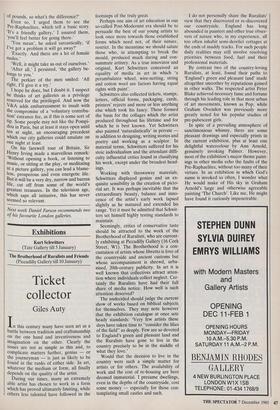ARTS
Galleries
Eye-openers up North
Daniel Farson
There was a distressing incident which I witnessed last year in the Manchester City Art Gallery. This has been restored to its Victorian splendour by Timothy Clifford and is a treat to visit. After paying my respects to the Duccio 'Crucifixion' which he saved for the nation by raising £1.8 million — 'dirt cheap at the price' — I went to see the 'Cheetah and Stag with Two Indians' by Stubbs when a group of cheer- ful young men strode round the corner, apparently straight off a building site. They stood out like a jolly Beryl Cook inserted into the sanctity of the Rothko Room at the Tate and their high spirits were so pleasing that I longed to ask what had prompted them: a sudden whim, perhaps, or the realisation of an old ambition? However, the woman behind the desk stared at them with cold dislike and when one of the men lit a cigarette she seized her opportunity — 'Smoking's forbidden.' She was in the right but her tone implied, `You're not the sort of person who should be here in the first place.' The man ground out his ciggy on the parquet floor, the pictures cringed in sympathy, the gallery lost its lustre and the men marched out without a painting seeen.
`What a bloody shame!' Timothy Clif- ford exclaimed when I told him this recent- ly in Edinburgh where he is now in charge of the Scottish Galleries and is trying to save Mantegna's 'Adoration of the Magi', though this time the price is £8,247,500 and time is running out. As someone who detests the 'mystique' surrounding art in this country, Clifford is an unashamed elitist when it comes to buying paintings 'You go for the masterpieces' — but is anxious that people should see them. `Carrot and stick, that's what we need to get them in. That's what it's all about.'
Unfortunately, many galleries exude a snobbery which suggests that art is for us but not for them. In Britain there is almost a class distinction when it comes to art, yet I doubt if our art galleries have ever been so needed, especially north of London. At a time of constant din and distraction, they provide oases of relaxation in cities where the hearts have been torn out, replaced by concrete desolation. Disconcertingly, many are half empty after the tourists have departed, and some are far from welcom- ing. Though it houses one of the finest collections in Britain, the Barber Institute at Birmingham University had only limited access when it was opened by Queen Mary in 1939 and even now a pink slip of paper informs one begrudgingly: 'Whilst not a public gallery, the Barber Institute is nor- mally open to individual members of the public during normal opening hours', pre- sumably with a sharp look-out to ensure that the visitors are normal too and are not wearing dirty working-clothes like the group routed in Manchester. In fairness, the attendants inside the Barber could not be kinder.
It is a sad fact of gallery-going, but most people never set foot in their local gallery, believing that it is too daunting a prospect, a cloistered place where people 'talk in whispers. Directors should use every trick to get them in, resorting to bribes, com- petitions, prizes, even free beer if neces- sary. All credit therefore to the welcome exceptions, like Clifford Stevens at the Walker in Liverpool with his exhibitions of Beatles' art, and children's paintings which encourage the doting relatives to look at other pictures too.
Some of the buildings cannot help them- selves, great, Gothic cathedrals like the Glasgow City Art Gallery, but this does not diminish the radiance of the paintings with such rewards as Van Gogh's portrait of Alexander Reid which looks as fresh as if it had been painted yesterday. Reid was a Scottish art dealer (Reid, Lefevre) who failed to buy a Van Gogh but bought extensively for the shipowner Sir William Burrell whose collection can be seen on the outskirts of Glasgow today. He had the reputation of being a mean millionaire but he was discerning enough to buy the Romanesque gateway for £150 and other stonework bought originally for vaster sums by William Randolph Hearst for his folly of San Simeon. These blend effective- ly with the light structure designed by Barry Gasson, with the vista of a wood 'I'm running away to join the circus.' beyond a room containing sculpture, and the restaurant seemingly in the open air. The Burrell is exemplary and the public has responded gratefully. More than two million people have come here since the opening by the Queen in October 1983 making this the biggest provincial gallery attendance, and allegedly the 'leading tourist attraction in Scotland'. Inevitably, most of the visitors come from outside: 'In the summer we have more Americans than British.'
The reluctance to visit the gallery on your doorstep was confirmed by the taxi- driver who took me to the Hunterian at Glasgow University to see the Whistler collection and the reproduction of the house of Rennie Mackintosh. He has taken numerous people here but has never been inside himself though he had actually lived in a house designed by Mackintosh. Though Rennie Mackintosh is interna- tionally famous today, the driver doubted if many Glaswegians are interested in the Scottish architect who died in 1928: 'I asked my mother if she knew Rennie Mackintosh and she said no, but I could bring him home to tea.'
I am lucky in having a special incentive in visiting art galleries in order to find paintings for the art-quiz Gallery I have devised for Channel 4, and part of the point of Gallery is to encourage people to see the pictures for themselves, for no reproduction can convey the subtlety, the texture and the scale of the original. As a layman I have been exhilarated to 'dis- cover' not only the familiar but real eye- openers in every sense: the 'Lady in a Fur Wrap', which was painted by El Greco in 1557 though it might have been done by Sargent, in Pollok House which is within walking distance of the Burrell; the de- lightful naive of the lady grocer in the People's Palace, Glasgow; the vitality of the young Scottish artists shown at the 369 Gallery in Edinburgh which has a first-rate bar and restaurant to resort to afterwards.
In Liverpool, I tried to share my enthu- siasm for the Lady Lever Gallery at Port Sunlight, where I had spent the morning, with two men drinking beside me in the Central pub. But when I asked if they had been there, I was told: 'The only people who go to such places are art students, old-age pensioners and those on the dole.' Three deserving categories, with the in- escapable irony that Lord Leverhulme built his gallery for his workers to relax in after hard toil.
wouldn't go myself,' one of the men explained, 'because I don't understand any of it. My mam has pictures on the walls, reproductions like, which mean the world to her, as much as those sold for thousands of pounds, so what's the difference?'
Even so, I urged them to see the Pre-Raphaelites, which tell a basic story. :It's a friendly gallery,' I assured them, you'll feel better for going there.'
`You mean', he asked sarcastically, 'if I've got a problem it will go away?' `Exactly. And there are a lot of female nudes.'
`Well, it might take us out of ourselves.' `After all,' I persisted, 'the gallery be- longs to you.'
The perkier of the men smiled: 'All right, I'll give it a try.' I hope he does, but I doubt it. I suspect he thinks of art galleries as a privilege reserved for the privileged. And now the V&A adds embarrassment to insult with the compromise of a 'voluntary contribu- tion' entrance fee, as if this is some sort of tip. Some people may not like the Pompi- dou in Paris, but at least it stays open until ten at night, an encouraging precedent which our city galleries could emulate on one night at least.
On his farewell tour of Britain, Sir Henry Irving made a marvellous remark: Without opening a book, or listening to music, or sitting at the play, or meditating at a picture gallery, you can lead a blame- less, prosperous and even energetic life. But it will be a very dry, narrow and barren life, cut off from some of the world's greatest treasures. In the television age, which saps all initiative, this has never seemed so relevant.
Next week Daniel Farson recommends two of his favourite London galleries.



































































 Previous page
Previous page